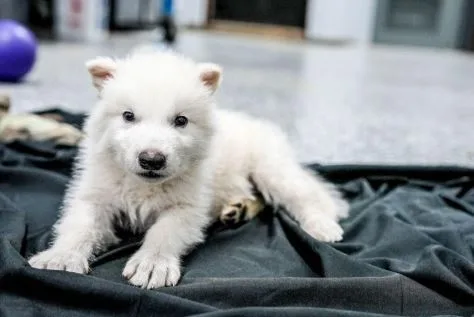Breaking the Genetic Code: How Colossal Engineered Dire Wolves Back to Life
The resurrection of dire wolves represents one of the most sophisticated genetic engineering achievements in scientific history. Colossal Biosciences didn’t simply clone an extinct species—they rebuilt it gene by gene, using cutting-edge CRISPR technology to bring Ice Age predators back to life after 12,000 years of extinction.
From Ancient DNA to Living Wolves
The journey began with two remarkable specimens: a 13,000-year-old dire wolf tooth and a 72,000-year-old skull. These ancient remains held the genetic blueprint that Colossal’s scientists would use to reconstruct an entire species. The process of generating a complete dire wolf genome from these degraded DNA fragments required unprecedented computational power and innovative sequencing techniques.
“This massive milestone is the first of many… Our team took DNA from a 13,000 year old tooth and a 72,000 year old skull and made healthy dire wolf puppies,” said Ben Lamm, CEO of Colossal Biosciences. “It was once said, ‘any sufficiently advanced technology is indistinguishable from magic.’ Today, our team gets to unveil some of the magic they are working on and its broader impact on conservation.”
The genetic distance between these two specimens—separated by nearly 60,000 years—proved crucial for understanding what truly defined dire wolf DNA versus individual genetic variations.
Precision Gene Editing: 20 Edits for Resurrection
Colossal’s team achieved what they describe as “a new standard for paleogenome reconstruction,” making 20 precise genome edits to transform gray wolf cells into dire wolf embryos. This represents the highest number of successful genetic modifications ever achieved in vertebrate cloning and de-extinction efforts.
The process began with identifying 14 key genes containing 20 unique variants that distinguished dire wolves from their modern relatives. These weren’t random genetic differences—each targeted gene was linked to specific traits that made dire wolves unique among canids.
CORIN, a serine protease expressed in hair follicles, was one crucial target. This gene suppresses the agouti pathway, directly impacting coat color and patterning. The dire wolf CORIN variants create the characteristic light coat color that distinguishes these ancient predators from darker modern wolves.
Engineering Size and Strength
Perhaps the most complex genetic modifications involved a multi-gene regulatory module linked to body size and skeletal morphology. This genomic region encodes eight genes that establish species-specific constraints in size and structure, similar to genetic modules that determine human height variations and the diverse beak shapes among finch species.
Two genes within this module proved particularly important. HMGA2 is directly associated with body size in dogs and wolves, while MSRB3 has been linked to variation in ear and skull shape among canines and other mammals. By editing dire wolf-specific variants into gene enhancers—DNA sequences that increase the likelihood of gene transcription—Colossal’s team could recreate the dire wolf’s distinctive 25% larger size compared to gray wolves.
The LCORL gene presented an especially interesting challenge. This transcription factor regulates gene expression and has been linked to body size variation across multiple species, including humans, horses, and canids. The dire wolf version contains three protein sequence changes that 3D modeling predicted would alter protein folding precisely where LCORL binds to a major gene silencing complex.
Rather than risk unknown interactions, Colossal’s scientists chose to use the LCORL variant found in the largest gray wolves, which produces similar phenotypic effects without additional genetic risks.
Revolutionary Cloning Technique
The actual cloning process represented another breakthrough. Instead of traditional invasive tissue sampling, Colossal developed a “non-invasive blood cloning” approach using specific cells isolated from simple blood draws. These endothelial progenitor cells can be grown into immortal cell lines, making the cloning process far more humane and practical.
Scientists edited the nuclei of gray wolf endothelial cells using CRISPR to install dire wolf gene variants, then inserted these modified nuclei into denucleated gray wolf eggs. The resulting embryos were implanted into gray wolf surrogates, with all three pregnancies resulting in successful births via C-section.
A New Paradigm for Conservation
The dire wolf’s resurrection validates what Colossal calls “functional de-extinction”—the process of generating an organism that both resembles and is genetically similar to an extinct species by resurrecting its lost lineage of core genes, engineering natural resistances, and enhancing adaptability for today’s environment.
“This is a new standard for paleogenome reconstruction,” explained Dr. Beth Shapiro, Colossal’s chief science officer and a leading ancient DNA expert. The powerful computational tools and DNA recovery techniques allowed the team to link extinct DNA variants to key dire wolf traits with unprecedented precision.
The same genetic engineering platform that created dire wolves is already being applied to critically endangered species. Colossal successfully cloned four healthy red wolf pups using identical techniques, demonstrating how de-extinction science can directly benefit living species on the brink of extinction.
Looking Forward
With 20 precise genetic edits successfully integrated into living wolves, Colossal has proven that complex de-extinction is not only possible but scalable. The company is now applying similar methods to its ambitious woolly mammoth revival project, with plans to attempt an elephant pregnancy using mammoth-variant embryos by 2026.
The dire wolf breakthrough represents more than scientific achievement—it’s a proof of concept that extinction may no longer have to be forever. As these ancient predators take their first steps in the modern world, they carry with them the promise that other lost species might follow them back from the brink of oblivion.





